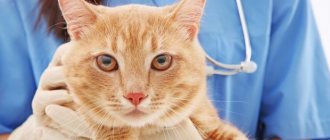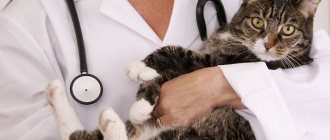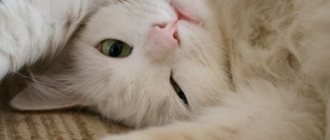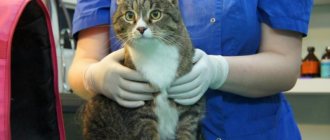7422Administration
Any signs of disease in cats should be investigated, both serious and insignificant at first glance. For example, such as if a cat's nipple is swollen. Because these animals are patient and are ready to put up with the fact that something is going wrong in their body. They only begin to be capricious when the disease takes on serious forms, and nothing can be returned back.
That is why, if you just notice that your cat’s nipple is swollen, sound the alarm: collect information, analyze the cat’s recent behavior, whether there are other signs, perhaps the other nipple is swollen, or ulcers have appeared, etc. Whatever it is, it’s worth noting all this and going with your cat to the veterinary clinic for a detailed examination as soon as possible.
© shutterstock
What could be a sign that the nipple is swollen and red? What actions are needed?
What is this?
A mammary gland tumor (MBT) in cats is a neoplasm that can be benign or malignant. Unfortunately, in 9 out of 10 cases it is malignant, and most often it is a fairly aggressive carcinoma.
The risk group includes adult cats - from 10-12 years old. Oncology is less common in young animals. However, it is impossible to determine the nature of the tumor during routine examination and palpation. To make an accurate diagnosis, you will need to undergo mandatory studies and tests.
List and description of possible causes
If a cat develops a ball on the nipple at a young age, there is a good chance that this symptom is not associated with malignant processes, but in the future it is necessary to keep in mind the following pathologies.
Mastitis
An inflammatory disease of the mammary glands, which usually appears during the postpartum period and during pseudolactation. Due to excess milk, swelling may appear on the nipples. Without pumping, the process can be complicated by pain in the abdominal cavity. In advanced cases, abscesses and deep ulcers may appear.
Treatment is individual depending on the clinic. The drugs Mastomethrin and Monclavit may be prescribed. In the presence of abscesses, surgical intervention, antiseptic treatment of wounds and drainage are indicated.
Neoplasms
The worst problem for most cats is that the mortality rate when mammary tumors are detected is quite high. Most oncologists assure that any tumor on the nipple can be considered conditionally benign, since surgical intervention with subsequent removal of the lump is still required.
Malignant neoplasms occur in animals after 10 years of age. The process can last for several years without showing itself in any way. But, at one point, the pet develops single or multiple formations near the nipples, which “before our eyes” increase in size.
The best decision is to immediately contact an oncologist for an abdominal ultrasound, radiography and visual examination (palpation of all nipples). There is always a lot of controversy about removal, since cancers almost always affect older individuals who have little chance of surviving anesthesia. But, refusal to remove the tumor will undoubtedly lead to the pet experiencing excruciating pain when it begins to ulcerate (this always happens in the last stages), bleed and fester.
Benign tumors are successfully excised (almost always not the nipple itself, but the entire mammary gland) and the risk of developing malignant tumors in the mammary gland area is reduced to a minimum.
Abscess
Another inflammatory process that can occur in the mammary glands. Most often, the appearance of ulcers provokes stagnation of milk after childbirth or during pseudolactation. The cat develops soft nodules near the nipple, reaching the size of a small pea.
The inside of abscesses is filled with pus, which is removed surgically after opening the abscess. Antiseptic treatment of wounds and wearing a protective blanket are indicated to prevent secondary infection. Antibiotic therapy is also indicated, which is selected by a veterinarian based on the clinical picture.
Blocked milk ducts
It can also lead to the appearance of lumps on the nipples. At the same time, there is an increase in size and redness. When touched, the cat experiences pain. Treatment includes special compresses applied to the abdominal cavity to relieve swelling, diuretics, and exclusion of food for at least 12 hours. Occurs immediately before childbirth and in the first 5-10 days after it.
Lack of or difficult milk output can also cause a lump to appear near the nipple. At the same time, the cat behaves restlessly and does not allow the cubs to approach it. This can be explained by a defect in the development of the mammary gland, which cannot be treated.
Separately, I would like to avoid injuries and foreign bodies entering the abdominal area, which can also cause swelling of one or several nipples at once. Hematomas usually disappear without a trace within 5-7 days without the use of any means. With foreign bodies, everything is much more complicated, since they can fester and cause the appearance of an abscess, which is described above.
Causes of tumor appearance
The causes of mammary tumors in cats are not fully understood. However, very often the disease is diagnosed in pets taking hormonal medications aimed at suppressing sexual arousal.
As a result of disruption of the functioning of the endocrine glands, severe hormonal disruption occurs. It entails improper functioning of internal organs, including the organs of the reproductive system. In 99% of cases, animals that have not had their ovaries removed are susceptible to cancer.
Note! Another common reason is a genetic predisposition.
It is formed when a mutated gene is transmitted, leading to uncontrolled cell division.
Possible causes of breast swelling and swollen nipples in a cat
Inflammation can be caused by the penetration of pathogenic microorganisms into the gland; a tumor often indicates the development of mastitis and mastopathy. Hormones have a great influence on the condition of the mammary glands. Hormonal imbalances also often lead to swollen nipples and the appearance of a variety of discharge. Most often, cats develop cancer. The risk of cancer increases in animals aged 10–12 years.
Natural factors
If the glands are swollen, this does not always indicate the presence of pathology. Natural causes of this condition are pregnancy and breastfeeding. Nipple enlargement occurs in the fourth week of pregnancy. This sign is especially well expressed in nulliparous females.
Pathological processes
If the female is not pregnant, then most likely the tumor is caused by pathological processes. They can occur as a result of hormonal imbalances, the use of hormone-based drugs, poor ecology, and poor nutrition. The most common breast diseases are:
- neoplasms;
- mastitis (serous, purulent);
- mastopathy;
- false pregnancy.
Main signs and stages
Symptoms of mammary tumors in cats do not appear in the early stages. The exception is neoplasms that have the form of small nodules and are located in the abdominal area. Unfortunately, most owners do not notice these changes.
Signs of a malignant tumor:
- Stage I
The size of the tumor ranges from 0.3-0.5 to 1-1.5 cm. When palpating the abdominal area, you can feel a slight “graininess”. At this stage, the pet is not bothered by pain. His activity remains and his appetite is normal.
- Stage II
New growths rapidly increase in size - up to 2-3 cm. New, not yet enlarged, lesions can be palpated on nearby mammary glands. However, the pet's condition is normal and he does not experience any discomfort.
- Stage III
The size of the neoplasms reaches from 3 to 5 cm. The behavior and mood of the pet changes. More often he is depressed and refuses food. When palpating the abdominal area, it reacts painfully. An ammonia smell appears.
- IV stage
Ulceration of the tumor usually occurs. It grows noticeably and begins to penetrate nearby tissues. An unpleasant odor appears. The pet's condition worsens, weight loss and difficulty breathing are observed.
If you notice one or more signs of cancer in your pet, contact an experienced veterinarian immediately. Do not try to make a diagnosis or prescribe treatment at home, otherwise you will not be able to avoid irreversible consequences.
Pet's condition
If your four-legged friend is dear and close to you, then you will notice his unusual behavior without much effort. In case of malignant diseases of the mammary gland (cancer), both cats and dogs often lick the affected area and then chew it. The tumor opens, non-healing ulcers form on the skin, from which fluid is released.
Hurry up and consult a veterinarian - he will prescribe an ultrasound of the mammary glands and determine the operability of your beloved cat/dog.
But, in the case when the inexorable mammary gland cancer (intraductal) has spread its metastases throughout the pet’s body, then the operation will not solve anything. Fate has given your friend a short term. You must clearly understand this and the best thing you can do is to save your pet from suffering. Whatever remorse you may feel, be guided by the interests of your loved one.
Diagnosis of AMF
If you notice any changes in your cat's mammary glands, do not hesitate - make an appointment at the veterinary clinic. Only a specialist can make an accurate diagnosis for your pet.
The first stage of diagnosis is an external examination. Particular attention is paid to the area where the mammary glands are located. The doctor probes each lesion and gland so as not to miss changes. If necessary, a biopsy (examination of cell samples) is prescribed.
Additionally, blood samples are taken for biochemical and clinical analysis. This will allow you to find out how the internal organs function and whether there are accompanying pathological processes in the body.
The next stage of tumor diagnosis is an X-ray examination of the lungs, which allows one to exclude or confirm the presence of metastases in them. If the cancer spreads to the lungs, the cat may have difficulty breathing and develop shortness of breath.
Symptoms and diagnosis
Most owners are attentive to their pets and try not to ignore any changes in behavior or appearance. But, nevertheless, it is possible to detect a tumor only when it has passed the stage at which external signs are detected:
- the cat's mammary gland is swollen;
- temperature increase;
- the animal refuses food and quickly loses weight;
- lumps are felt in the area of the mammary glands;
- upon palpation the animal experiences pain;
- purulent discharge from the nipple is likely.
Treatment of breast tumor
What to do if your cat has a mammary tumor? Immediately after diagnosis, the specialist will develop an individual treatment plan, taking into account the pet’s age, the characteristics of its body, the nature and stage of tumor development.
The main goal of treatment is to destroy tumor cells and stop their division. This will not only prevent the further development of oncology, but will also completely eliminate its recurrence in the future. Among the main treatment methods:
- surgical intervention,
- radiation therapy,
- cryodestruction,
- chemotherapy,
- hyperthermia, etc.
The choice of treatment method depends on the location of the tumors and their sensitivity to medical intervention. If necessary, combination therapy is prescribed, combining several types of possible treatment for the pet.
Mastopathy
Chronic mastitis can cause mastopathy.
It is generally accepted that the main cause of mastopathy is hormonal disorders. However, this pathology can occur as a complication of chronic mastitis.
The main symptoms are associated with enlarged mammary glands.
- The provoking cause, the factor of which is a stagnant process, is characterized by fibroepithelial hyperplasia of a diffuse form.
- The entire area increases in size with the presence of multiple compactions, and not only individual compactions are painful, but also the entire inflamed area.
- If ulcers begin to appear, help will be very difficult and the effectiveness of the prescribed treatment will remain in question.
Treatment
If a cat is diagnosed with an advanced form of the disease, the only way to help it is through surgery.
A serious lesion entails surgical intervention with partial removal of the affected bags or a complete mastectomy, which implies removal of the uterus along with the ovaries.
Such a radical method is required when the form is advanced, when there is nothing else to help the pet.
In milder cases, iodine-containing drugs, anti-inflammatory drugs, homeopathic medicines, and immunomodulators are used.
Surgical removal
The most common way to treat a mammary tumor in a cat, whether benign or malignant, is surgery. Sometimes it is enough to remove a local lump (neoplasm), but usually it is necessary to remove the entire mammary gland and the lymph nodes draining it.
If a malignant tumor affects two or more mammary glands, then they are removed together - the entire row on the left or right side. In particularly severe cases, a bilateral mastectomy may be prescribed, i.e. removal of all the mammary glands of the cat and the lymph nodes draining them.
Sterilizing an animal before puberty significantly reduces the likelihood of tumor formation. In some cases, it is performed already during the treatment of oncology. Sterilization does not affect the growth of a malignant tumor, but can lead to regression of dysplasia.
In the final stages of cancer, all mammary glands and lymph nodes have to be removed. However, even in this case, the pet’s complete recovery cannot be guaranteed. Additionally, systemic chemotherapy may be prescribed before/after surgery.
Mastitis
Today it is the most common disease. May occur after childbirth (or during false pregnancy). Its pronounced symptoms:
- At stage 1, the skin around the nipple turns red and swells, and the discharge contains blood or pus (see photo).
- On the 2nd, an increase in the animal’s body temperature is possible.
Mastitis-like inflammation in cats and dogs goes away quickly and without any consequences in the future.
The only thing the owner can do is to isolate newborn kittens (puppies) and transfer them to artificial feeding so that the initiated milk from an unhealthy mother does not cause digestive upset in them.
What should the owner do?
If your cat is diagnosed with a mammary tumor, you will need to prevent rubbing, scratching, or licking the affected mammary glands until surgery. This will reduce:
- inflammatory processes,
- itching,
- ulcers,
- risk of infection.
Note! Any damage to your pet's skin must be kept clean.
After surgical removal of a benign or malignant lesion, ensure that the surgical suture remains dry and clean. If inflammation or suture separation is detected, immediately contact your veterinarian.
Caring for your cat after surgery
The result of treatment depends not only on timely surgery. Surgical removal of the tumor is only the initial stage of the fight against cancer. Postoperative care plays an important role. A pet who has undergone surgery must be provided with complete rest. In addition, you must follow your veterinarian's instructions and follow all recommendations regarding your cat's diet.
The seam must be regularly treated with a special product, which is also prescribed by the veterinarian. In addition, the animal must be given a number of medications, strictly observing the time of administration and dosage. This will help avoid complications.
For some time after removal of the tumor, the cat must wear a special blanket. It is designed to protect the seam and prevent inflammation. The owner must carefully ensure that the blanket is held securely and does not come undone.
Scheduled inspections are carried out weekly. To assess the animal’s condition and understand how its recovery process is going, the veterinarian will take the necessary tests. However, even the most experienced doctor cannot say exactly how long a cat will live after surgery.
Postoperative care and restrictions
Most cats are discharged from the hospital after surgical removal of the tumor after 2-5 days, depending on their condition. You must make an appointment with an oncologist 12-16 days after the operation so that the specialist can re-examine the patient and remove the sutures.
Restrictions during the rehabilitation period (10-14 days):
- collar or blanket,
- limitation of mobility,
- proper nutrition,
- caring for the suturing area.
If the neoplasm is malignant, you will need to visit a veterinary clinic every 3 months.
Mastopathy in a cat
It happens that some time passes after sterilization and the owner notices swelling of the mammary glands in his pet.
With more careful palpation, you can feel small compactions with a soft or springy consistency . This is how mastopathy manifests itself. The initial stage of the disease does not cause a painful syndrome, so timely diagnosis of the pathology is of great importance.
If such a symptom is detected, you should immediately contact the clinic for a correct diagnosis and treatment.
If symptoms of mastopathy appear, you should immediately contact a veterinarian!
Diagnostics
Diagnosed using histological examination.
Histological examination.
Risk group
Females who have been spayed after at least their second heat are more at risk.
Younger females who have had their ovaries removed before their first estrus are very rarely susceptible to developing this disease.
Young cats are less susceptible to the disease after surgery.
Treatment
Treatment is prescribed depending on the severity of the course.
If the disease is diagnosed late, surgery is recommended, during which the affected tissue or completely swollen gland is removed.
If the disease is detected late, surgical intervention is recommended.
The initial stage is amenable to drug treatment. The use of immunomodulatory drugs to enhance the body's resistance is indicated. Iodine-containing medications are prescribed to stop the growth of pathological tissue.
To prevent secondary infections and eliminate pain, treatment with anti-inflammatory drugs is recommended.
homeopathic remedies are used to restore the female’s hormonal levels. Under no circumstances should you use warm compresses or lotions for mastopathy. Heat provokes the proliferation of diseased cells.
What you need to know about benign tumors?
Benign tumors of the mammary glands are diagnosed in cats in 1% of cases, precancerous conditions - in 20% of cases. They are usually formed from the epithelium that produces milk; less often they affect other glandular tissues.
If your cat is diagnosed with a benign tumor, do not refuse treatment. Over time, they can become malignant (for example, under the influence of a certain group of diseases). The most effective treatment is surgical removal of tissue in the early stages.
Problems with early weaning of kittens from cats
Early weaning can lead to stress and even various diseases in the cat.
If the female has the first litter, it is not recommended to select all the babies at once in order to avoid stress and, as a result, the development of diseases.
The most common problem in the case of early weaning is disturbances in the functioning of the mammary gland. The cat is not able to cope with stress on its own and the lactation process continues.
In such situations, the cat's risk of developing mastitis increases.
Due to ongoing lactation and the inability of kittens to produce milk, the risk of developing mastitis or mastopathy increases.
At such moments, the cat becomes aggressive, does not make contact with the owners, and refuses food and water. Most often, after a certain time, the stressful state fades away if the owner makes every effort to do so.
- To do this, you should create the most comfortable conditions for mommy.
- Eliminate stressful situations, eliminate noise and contact with strangers, show great care and speak in a calm, gentle voice.
If, despite apparent calm, the cat’s mammary glands are swollen, this may indicate the development of a disease such as mastitis. Prolonged ignoring of the symptoms of mastitis provokes a more serious disease – mastopathy.
We invite you to familiarize yourself with: Asherah cat. Description, features, care and price of an Asher cat
If inflammation of the mammary glands is detected in an animal, you should contact a veterinarian.
In this case, the cause of mastitis is stagnation of milk in the mammary glands, as a result of which milk accumulates and begins to “spoil”, which will cause the development of a pathological process.
To detect mastitis in a timely manner after kittens are weaned, you should be extremely attentive to your pet. Check the condition of the glands every day and consult a doctor at the slightest swelling. Any delay is fraught with serious complications. Main features:
- hyperemia;
- swelling;
- nipple hyperthermia;
- hardening of the nipples;
- possible cracks in the area of the inflamed area;
- obvious pain in the affected area;
- frequent licking of nipples;
- when pressed, the selection has a curd-like character.
Cancer prevention
To reduce the likelihood of developing cancer in your cat, it is necessary to carry out sterilization in a timely manner. The recommended age for a pet is before the animal reaches puberty. At the same time, sterilization does not 100% exclude the appearance of neoplasms.
As soon as the animal reaches the most dangerous age (from 8 years), it is recommended to undergo a thorough examination at a veterinary clinic - at least once every six months. This will allow you to identify the tumor in the initial stages and completely cure your pet.
Proper care, attentive attitude and professional veterinary care are the best prevention of cancer for every cat!
Preventive measures
Owners of domestic cats should carefully monitor the condition of their pet's nipples, since tumors in them are most often malignant. If even small balls appear under the skin, it is necessary to urgently show the animal to a veterinarian. To protect your pet from this terrible diagnosis, you need to follow the recommendations of specialists:
- Sterilize a nulliparous female before puberty. Many scientific studies have shown that spayed females have a reduced risk of developing malignant tumors on the mammary glands.
- Do not use hormonal contraceptives. During the period of female heat, people usually use veterinary drugs that neutralize its symptoms. These medications contain hormonal substances that disrupt the activity of the animal’s own gonads.
- Use quality feed. Cheap food with a large number of additives and carcinogens is one of the reasons for the development of cancer in animals.
If the nipple is swollen due to mastitis or mastopathy, then the prognosis in this case will be favorable. However, mastitis also causes a lot of trouble for the animal, so it is better to try to prevent it. Prevention of this disease includes the following measures:
- regular antiparasitic treatment;
- eliminating the possibility of your pet getting injured and hypothermia;
- preventing stagnation of milk in the breast of a nursing female, applying kittens to all nipples;
- frequent change of bedding for a female with kittens;
- trimming babies' claws if they damage the skin on the mother's chest;
- the use of special ointments for cracks in the areolas and nipples.











